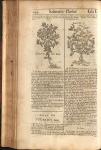
 I. The Names. They are called in Greek *******, In Latin, Tribulus: In English Caltrops. The Arabians call this Plant Hasach, and Haserk; the Spaniard, Abrolos, and the French, Saligot.
I. The Names. They are called in Greek *******, In Latin, Tribulus: In English Caltrops. The Arabians call this Plant Hasach, and Haserk; the Spaniard, Abrolos, and the French, Saligot.
II. The Kinds. It is twofold, first of the Land called in Greek, ******; in Latin, Tribulus terrestris; and in English, Land Caltrops of which in this Chapter. Secondly, Water Caltrops, of which in the next.
III. The Description. Land Caltrop has a Root which is white, grows downwards, and has many Fibres or Strings. From this Root rise up several hard, small, long Branches, full of Joints, and spread abroad upon the ground; which are furnished with many winged Leaves, having a middle Rib, on which stand several small Leaves, on both sides the said Rib, after the manner of Orobus or Vetches. At the Joints come forth singly, small, pale, whitish Flowers, consisting of five small Leaves, like the Flowers of Tormentil. These being past, there comes forth little, rough, prickly heads, full of Prickles, and having five or six Corners, within which prickly Husk lies the Kernel or Seed.
IV. The Places. It is said to grow plentifully in Spain in their fields, being sometimes hurtful to Corn: It is also found in most places of Italy and France: And, as Gerard says, it grows with us in England; he found it in a moist Meadow adjoining to the then Wood or Park of Sir Francis Carew, near Croydon, not far from London, from whence he brought Plants of it for his Garden. Parkinson says it grows amongst Rubbish, and the Ruins of Buildings, and by Walls sides.
V. The Times It Flowers in June and July; and the fruit or Seed is ripe in August.
VI. The Qualities. It is cold in the first Degree, and dry in the second. It is Astringent and Repercussive, it is Alterative and Alexipharmick.
VII. The Specification. By reason it is of thin Parts, it is said to waste the Stone, Tartar, or Gravel in the Reins, and parts adjacent.
1. A liquid Juice.
2. An Essence.
3. A Decoction.
4. A Pouder of the Root.
5. A Collyrium.
6. A Cataplasm of the Leaves.
7. A Lotion.
8. The Seed.
The Virtues.
IX. The liquid Juice. Being applied, it abates the Inflammation, and cures an Erysipelas: It hinders the breeding of Inflammations and Apostems, and stops the Flux of Humors; and being drank from two ounces to four, it breaks or wastes the Stone in the Reins, expelling Sand, Gravel, and Tartarous Humors and stops all sorts of Fluxes of the Bowels.
 X. The Essence. It has all the same Virtues, and the more pleasant Medicine to take. It cures sore Eyes, being dropt into them, and abating the Inflammation, takes away the Bloodshot. If it is drank to two or three ounces in Wine, it prevails against the poison of the Viper, and the bitings of other Venomous Beasts.
X. The Essence. It has all the same Virtues, and the more pleasant Medicine to take. It cures sore Eyes, being dropt into them, and abating the Inflammation, takes away the Bloodshot. If it is drank to two or three ounces in Wine, it prevails against the poison of the Viper, and the bitings of other Venomous Beasts.
XI. The Decoction. It has the Virtues of the Juice and Essence, but not all out so powerful: It may serve as a good Vehicle to convey the Pouder of the Root in.
XII. The Pouder of the Root. It stops Fluxes of the Belly, and binds it: given to two drams, it is good against the biting of Vipers; consumes Nodes and Kernels in the Neck, or other Parts, and in a good measure strengthens the Stomach.
XIII. The Collyrium. It is made of the Juice or Essence made into a thin Syrup with Honey. This put into the Eye three or four times a day, stops fluxions of Humors into the Part, cools and takes away the Inflammation, and heals Sores or Ulcers therein.
XIV. The Cataplasm of the Leaves. It is good against a hot Gout, repercusses the flux of Humors, hinders Apostems, and discusses Swellings in the Legs, or other parts of the Body.
XV. The Lotion. It is made of the Decoction in Wine, in a quart of which, Honey three ounces, and Roch Allum half an ounce, is dissolved. It is made to heal corrupt Sores and Ulcers of the Mouth, Throat, and Gums and to cleanse Fistula's; as also Apostems newly broke, or opened, by injecting it with a Syringe.
XVI. The Seed or Fruit. It is Alexipharmick Galen and Pliny say, that the Thracians, who dwelt near the River Stirmon, lived themselves of the Fruit or Kernels, making them into a sweet and fine kind of Bread, which something bound up the Belly: And that with the Herb they fed their Horses. But this making Bread of the Kernels is affirmed by some, to be only meant of the Fruit of the Water Caltrop, following.
Botanologia, or The English Herbal, was written by William Salmon, M.D., in 1710.
This chapter has been proofread by Nick Jones.

